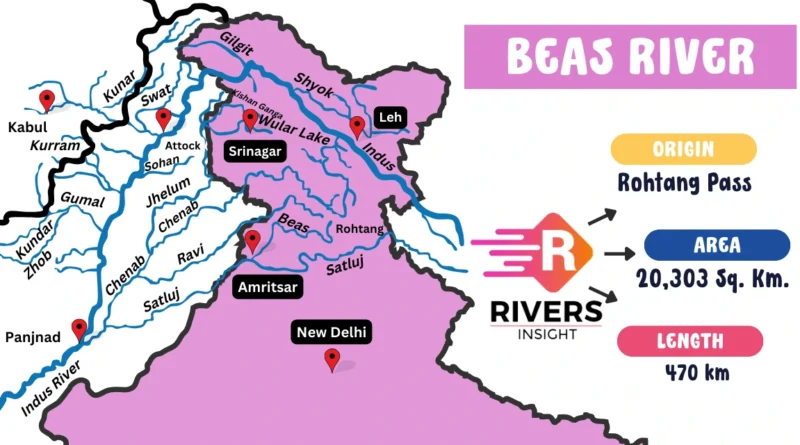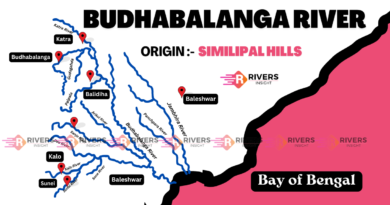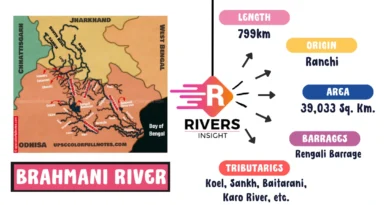Beas River – Map & Origin with Facts
The Beas River, also known as Bipasha in ancient texts, is a perennial snow-fed river that originates from the Himalayas and flows through the Indian states of Himachal Pradesh and Punjab. With a length of approximately 470 kilometers, it is one of the five major rivers of the Punjab region.
| River | Beas |
| Length | 470 km |
| Origin | Rohtang Pass |
| End in | Harike Patan |
Table of Contents
Origin and Course of Beas River
The Beas River flows for a total distance of approximately 470 kilometers before merging with the Satlej River. Originating from the Rohtang Pass in the Himalayas, the Beas River flows through the Kullu Valley in Himachal Pradesh, passing through the towns of Manali and Kullu, where it is joined by several tributaries, including the Parvati River.
As it continues its journey, the Beas River enters the Mandi District, flowing through a narrow gorge and being joined by the Uhl River. It then flows southwest through the Hamirpur District and enters the Kangra Valley, where it is joined by the Chaki River.
In the Punjab Plains, the Beas River forms a confluence with the Sutlej River at Harike Patan, a wetland area located in the Tarn Taran Sahib District of Punjab. The combined waters of the Beas and Sutlej Rivers then flow southwest and merge with the Chenab River, Jhelum River, and Ravi River at Panjnad (the meeting point of these five rivers).
From there, the combined waters flow as the Indus River, which continues to flow southwest. Finally, the Indus River flows into the Arabian Sea, emptying into the ocean near the port city of Karachi.
Map of Beas River

Geographical Features
- Birthplace: Rohtang Pass, Himalayas (Himachal Pradesh)
- Length: 470 km (290 miles)
- Flow: South through Himachal Pradesh and Punjab, joining the Sutlej River
- Altitude: From 4,361 meters (14,308 ft) at source to 300 meters (980 ft) at confluence
- Tributaries: Parbati, Sutlej, Uhl, Markanda, Banganga
- Valleys: Kullu, Kangra
- Dams: Pong Dam, Pandoh Dam, Largi Dam
- Landforms: Gorges, plains, floodplains
Tributaries
The following are the major tributaries of Beas:
- Parvati River
- Uhl River
- Chaki River
Conclusion
The Beas River, with its extensive network of tributaries, has played a significant role in shaping the region’s history and culture. The river has been an important factor in the development of civilizations in the region, with ancient texts like the Rigveda mentioning its significance. Throughout history, the Beas River has been a vital source of water, supporting agriculture, trade, and urbanization. Today, it remains a crucial component of the region’s ecosystem and economy.




